Demand for pea protein bakery fortification in the Commonwealth of Independent States (CIS) is estimated at USD 210 million in 2025, with projections indicating a rise to USD 420.9 million by 2035, reflecting a CAGR of approximately 7.2% over the forecast period.
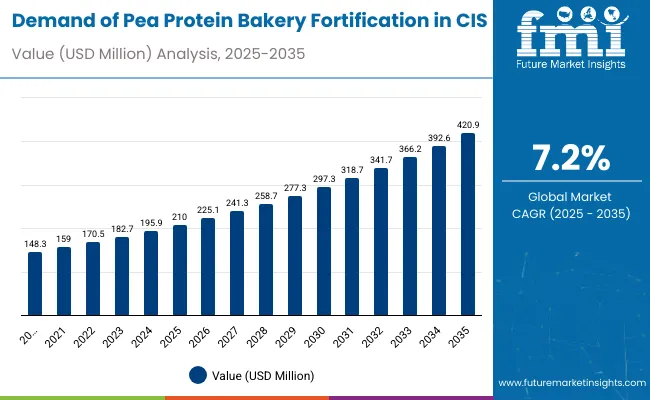
| Metric | Value |
|---|---|
| Industry Size (2025E) | USD 210 million |
| Industry Value (2035F) | USD 420.9 million |
| CAGR (2025 to 2035) | 7.2% |
This growth reflects both expanding consumer awareness of protein enrichment and increased adoption across commercial bakery operations in key urban centers. The rise in demand is linked to shifting nutritional preferences, growing focus on plant-based protein sources, and evolving health-conscious consumption patterns.
By 2025, per capita consumption in leading CIS states such as Russia, Kazakhstan, and Ukraine averages between 0.8 to 1.1 kilograms annually, with projections reaching 1.4 kilograms by 2035. (note, for this research scope, Ukraine has been considered in CIS)
The largest contribution to demand continues to come from bread and roll fortification applications, which are expected to account for 71% of total sales in 2025, owing to widespread bakery adoption, extended shelf stability, and consumer acceptance. By distribution channel, supermarkets and hypermarkets represent the dominant distribution channels, responsible for 48% of all demand, while commercial bakeries and industrial baking operations are expanding rapidly.
Consumer adoption is particularly concentrated among health-conscious urban families and fitness-oriented millennials, with income levels and nutritional awareness emerging as significant drivers of demand. While cost remains a limiting factor, the average price premium over conventional wheat-based fortification has declined from 28% in 2020 to 19% in 2025.
Continued improvements in processing scale and regional supply partnerships are expected to accelerate affordability and access across mid-income households. Regional disparities persist, but per capita demand in high-growth Central Asian cities is narrowing the gap with traditionally strong Russian urban hubs.
The pea protein bakery fortification segment in the CIS is classified across several categories. By product type, the key segments include pea protein isolate, pea protein concentrate, textured pea protein, and other specialized formulations. By distribution channel, the segment spans supermarkets and hypermarkets, bakery specialty stores, e-commerce platforms, convenience stores, and other retail formats. By protein concentration, formulations include standard blend (15-25% protein), medium concentrate (25-40% protein), high concentrate (40-60% protein), and specialty isolate applications above 60% protein content.
By consumer profile, the segment covers health-conscious urban families, fitness-oriented millennials, elderly nutrition-focused consumers, and individuals managing dietary protein requirements. By region, countries such as Russia, Kazakhstan, Ukraine, Belarus, and Uzbekistan are included, along with coverage across all 12 CIS member states. By city, key metro areas analyzed include Moscow, St. Petersburg, Almaty, Kiev, and Tashkent.
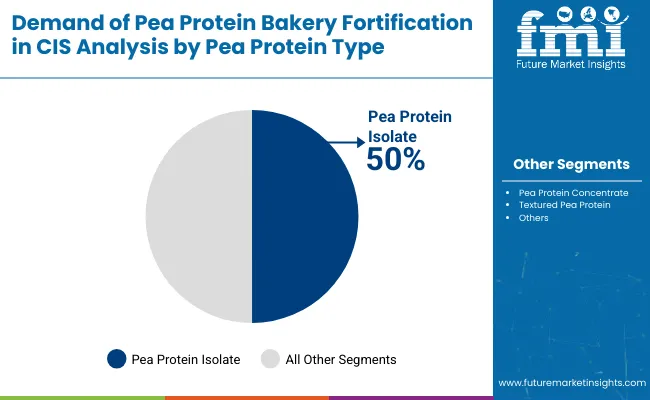
Pea protein isolate applications are projected to dominate demand in 2025, supported by superior nutritional profile, enhanced functionality, and growing consumer preference for high-quality protein fortification. Other product types such as concentrates, textured proteins, and specialty formulations are growing steadily, each serving distinct application needs.
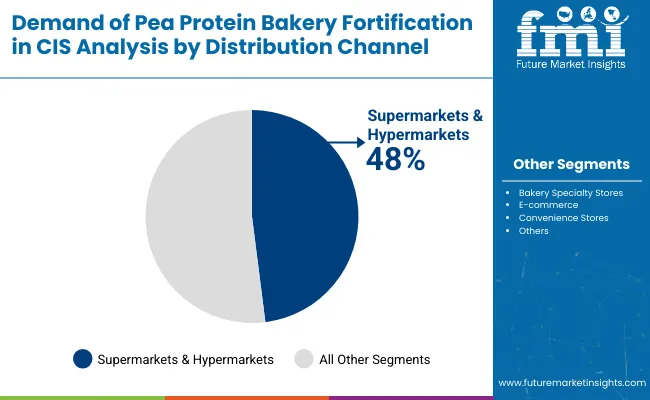
Pea protein bakery fortification in the CIS is distributed through diverse retail and commercial channels. Supermarkets and hypermarkets are expected to remain the primary distribution point in 2025, followed by specialty stores and emerging digital platforms. Distribution strategies are evolving to match consumer accessibility preferences, with growth coming from both traditional and modern retail formats.
Pea protein bakery fortification in the CIS utilizes varying concentration levels, selected for cost effectiveness, functional performance, and nutritional enhancement goals. Standard blend concentrations remain the most widely used input, though medium and high concentrate alternatives are gaining adoption. Product developers are increasingly exploring specialty isolate formulations to meet evolving nutritional and regulatory demands.
The pea protein bakery fortification category appeals to diverse consumer groups across age demographics, income levels, and nutritional preferences. While motivations vary from general health enhancement to specific fitness goals, demand concentrates among four key demographic clusters. Each group demonstrates distinct purchasing behaviors, channel preferences, and product expectations.
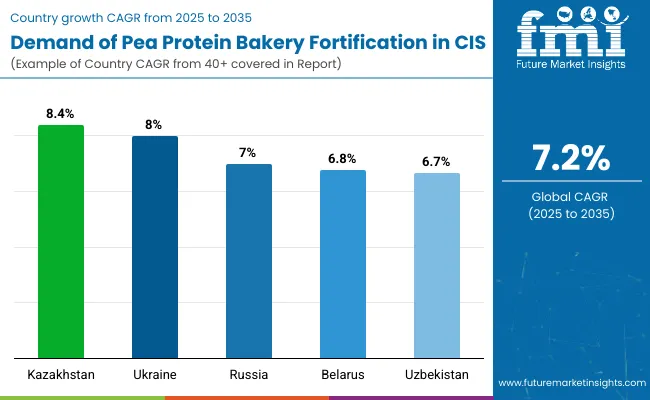
| Countries | CAGR (2025 to 2035) |
|---|---|
| Kazakhstan | 8.4% |
| Ukraine | 8.0% |
| Russia | 7.0% |
| Belarus | 6.8% |
| Uzbekistan | 6.7% |
Pea protein bakery fortification demand will not expand uniformly across every country. Rising health consciousness and faster nutritional awareness adoption in Central Asian nations give Kazakhstan and Ukraine a measurable advantage, while established Russian centers expand more steadily from higher baseline consumption. The table below shows the compound annual growth rate (CAGR) each of the five largest countries is expected to record between 2025 and 2035.
Between 2025 and 2035, demand for pea protein bakery fortification is projected to expand across all major CIS countries, but growth pace will vary based on health awareness trends, retail modernization, and baseline consumption patterns. Among the top five countries analyzed, Kazakhstan and Ukraine are expected to register the fastest compound annual growth rates of 8.4% and 8.0% respectively, outpacing more established consumption centers.
This acceleration stems from rapidly growing health consciousness, expanding modern retail penetration, and increasing availability of protein-enhanced products across supermarkets and specialty outlets. In both countries, per capita consumption is projected to rise significantly, closing the gap with higher-consumption markets such as Russia. Commercial bakery adoption is also accelerating in these regions, with new protein fortification capabilities gaining traction in traditional bread production and specialty health-focused operations.
Russia is forecast to grow at a CAGR of 7.0% over the same period, supported by established food processing capabilities and mature consumer interest in nutritional enhancement. The country maintains developed retail infrastructure with increasing adoption of protein fortification technologies across traditional and modern distribution channels. Per capita consumption reflects mainstream acceptance of protein-enhanced bakery products across major metropolitan areas.
Belarus and Uzbekistan, while maintaining steady growth trajectories, are expected to grow at CAGRs of 6.8% and 6.7% respectively. Both countries exhibit developing retail infrastructure with gradual expansion of protein fortification adoption across commercial and specialty applications.
Collectively, these five countries represent the core of demand for pea protein bakery fortification in the CIS, but their individual growth paths highlight the importance of regional tailoring in product positioning, pricing strategies, and distribution approaches.
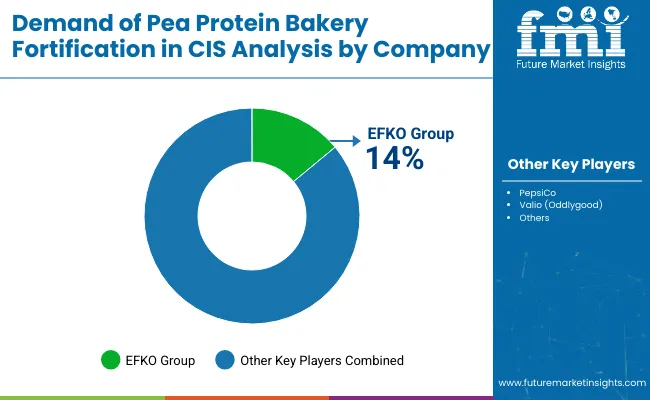
The competitive environment features a mix of established international protein suppliers and emerging regional players. Distribution reach and technical expertise rather than pure product variety remain decisive success factors, with leading suppliers collectively serving thousands of commercial bakeries across the CIS region and maintaining consistent ingredient availability for protein fortification applications.
EFKO Group maintains a leading position with 14% demand share, leveraging its strong regional presence and comprehensive supply chain capabilities to serve commercial bakeries across major CIS countries while providing technical support and competitive pricing for protein fortification applications.
Roquette Frères operates as a mature international supplier offering comprehensive pea protein solutions including standard blends, concentrates, and specialty isolates. The company leverages its global supply network and technical expertise to support commercial bakeries across major CIS territories while providing formulation guidance and quality assurance for protein fortification applications.
Ingredion, through its regional distribution partnerships, focuses on cost-effective protein solutions for large-scale commercial bakery operations, emphasizing functional performance and competitive pricing to support mainstream adoption of protein fortification across traditional bread production facilities.
BurconNutraScience supplies premium pea protein isolates for specialty applications, targeting health-focused bakeries and premium product segments while maintaining technical support for advanced formulation requirements and custom protein concentration needs.
The next tier includes regional suppliers and emerging companies. AGT Food and Ingredients leverages its pulse processing expertise to offer regionally sourced pea protein solutions, appealing to bakeries seeking local supply chain advantages and cost optimization. Axiom Foods focuses on organic and specialty pea protein formulations for artisanal and health-focused bakery applications.
Regional ingredient distributors across Russia, Kazakhstan, and Ukraine are expanding pea protein portfolios to serve local commercial bakeries, offering competitive pricing and localized technical support. Private label ingredient programs through major food distributors are beginning to emerge, potentially creating pricing pressure while supporting broader adoption across mid-sized bakery operations.
Consolidation among regional suppliers is expected as technical capabilities and supply chain scale become critical for maintaining consistent availability and competitive pricing in this developing category.
| Attribute | Details |
|---|---|
| Study Coverage | CIS demand and consumption of pea protein bakery fortification from 2020 to 2035 |
| Base Year | 2025 |
| Historical Data | 2020 |
| Forecast Period | 2025-2035 |
| Units of Measurement | USD (demand), Metric Tonnes (volume), Kilograms per capita (consumption) |
| Geography Covered | All 12 CIS member states; country-level and city-level granularity |
| Top Countries Analyzed | Russia, Kazakhstan, Ukraine, Belarus, Uzbekistan, 12+ |
| Top Cities Analyzed | Moscow, St. Petersburg, Almaty, Kiev, Tashkent and 25+ |
| By Product Type | Pea protein isolate, Pea protein concentrate, Textured pea protein, Others |
| By Distribution Channel | Supermarkets & hypermarkets, Bakery specialty stores, E-commerce, Convenience stores |
| By Protein Concentration | Standard blend (15-25%), Medium concentrate (25-40%), High concentrate (40-60%), Specialty isolate (60%+) |
| By Consumer Profile | Health-conscious families, Fitness-oriented millennials, Elderly nutrition-focused, Dietary restriction managers |
| Metrics Provided | Demand (USD), Volume (MT), Per capita consumption (kg), CAGR (2025-2035), Share by segment |
| Price Analysis | Average unit prices by concentration level and region |
| Competitive Landscape | Company profiles, regional distribution strategies, technical support capabilities |
| Forecast Drivers | Per capita protein awareness, commercial bakery adoption, cost convergence, urbanization trends |
By 2035, total CIS demand for pea protein bakery fortification is projected to reach USD 420.9 million, up from USD 210 million in 2025, reflecting a CAGR of approximately 7.2%.
Pea protein isolate holds the leading share, accounting for approximately 50% of total demand in 2025, followed by pea protein concentrate and textured pea protein applications.
Kazakhstan and Ukraine lead in projected growth, registering CAGRs of 8.4% and 8.0% respectively between 2025 and 2035, due to rising health consciousness and expanding retail modernization.
Supermarkets and hypermarkets represent the dominant distribution channel (48% share in 2025), while bakery specialty stores and e-commerce platforms are expanding rapidly, especially in urban centers.
Major players include EFKO Group (leading with 14% demand share), Roquette Frères, Ingredion, Burcon NutraScience, and AGT Food and Ingredients, with growing competition from regional distributors and specialized ingredient suppliers.






Our Research Products

The "Full Research Suite" delivers actionable market intel, deep dives on markets or technologies, so clients act faster, cut risk, and unlock growth.

The Leaderboard benchmarks and ranks top vendors, classifying them as Established Leaders, Leading Challengers, or Disruptors & Challengers.

Locates where complements amplify value and substitutes erode it, forecasting net impact by horizon

We deliver granular, decision-grade intel: market sizing, 5-year forecasts, pricing, adoption, usage, revenue, and operational KPIs—plus competitor tracking, regulation, and value chains—across 60 countries broadly.

Spot the shifts before they hit your P&L. We track inflection points, adoption curves, pricing moves, and ecosystem plays to show where demand is heading, why it is changing, and what to do next across high-growth markets and disruptive tech

Real-time reads of user behavior. We track shifting priorities, perceptions of today’s and next-gen services, and provider experience, then pace how fast tech moves from trial to adoption, blending buyer, consumer, and channel inputs with social signals (#WhySwitch, #UX).

Partner with our analyst team to build a custom report designed around your business priorities. From analysing market trends to assessing competitors or crafting bespoke datasets, we tailor insights to your needs.
Supplier Intelligence
Discovery & Profiling
Capacity & Footprint
Performance & Risk
Compliance & Governance
Commercial Readiness
Who Supplies Whom
Scorecards & Shortlists
Playbooks & Docs
Category Intelligence
Definition & Scope
Demand & Use Cases
Cost Drivers
Market Structure
Supply Chain Map
Trade & Policy
Operating Norms
Deliverables
Buyer Intelligence
Account Basics
Spend & Scope
Procurement Model
Vendor Requirements
Terms & Policies
Entry Strategy
Pain Points & Triggers
Outputs
Pricing Analysis
Benchmarks
Trends
Should-Cost
Indexation
Landed Cost
Commercial Terms
Deliverables
Brand Analysis
Positioning & Value Prop
Share & Presence
Customer Evidence
Go-to-Market
Digital & Reputation
Compliance & Trust
KPIs & Gaps
Outputs
Full Research Suite comprises of:
Market outlook & trends analysis
Interviews & case studies
Strategic recommendations
Vendor profiles & capabilities analysis
5-year forecasts
8 regions and 60+ country-level data splits
Market segment data splits
12 months of continuous data updates
DELIVERED AS:
PDF EXCEL ONLINE
Pea Protein Market Analysis - Size, Share, and Forecast Outlook 2025 to 2035
Pea Protein Ingredients Market Insights - Plant-Based Nutrition Growth 2025 to 2035
Chickpea Protein Market Analysis - Size, Share, and Forecast Outlook 2025 to 2035
Competitive Overview of Chickpea Protein Companies
Japan Pea Protein Market Analysis - Size, Share & Trends 2025 to 2035
Yellow Pea Protein Market Outlook - Growth, Demand & Forecast 2025 to 2035
UK Chickpea Protein Market Insights – Demand, Size & Industry Trends 2025–2035
USA Chickpea Protein Market Report – Trends, Demand & Industry Forecast 2025–2035
Pea Protein in Plant-Based Meat Analysis - Size Share and Forecast outlook 2025 to 2035
Pea Protein Demand in Dairy Alternatives Analysis - Size Share and Forecast outlook 2025 to 2035
Demand for Pea Protein RTM Dispersibility for Shaker Formats Size and Share Forecast Outlook 2025 to 2035
ASEAN Chickpea Protein Market Trends – Growth, Demand & Forecast 2025–2035
Europe Chickpea Protein Market Outlook – Size, Share & Forecast 2025–2035
Australia Chickpea Protein Market Outlook – Demand, Trends & Forecast 2025–2035
Western Europe Pea Protein Market Analysis - Size, Share & Trends 2025 to 2035
Latin America Chickpea Protein Market Analysis – Demand, Share & Forecast 2025–2035
Demand for Textured Pea for High Protein Savory in EU Size and Share Forecast Outlook 2025 to 2035
Trends, Growth, and Opportunity Analysis of Pea Protein in South Korea Size and Share Forecast Outlook 2025 to 2035
Pea Grits Market Size and Share Forecast Outlook 2025 to 2035
Protein-Coating Line Market Forecast Outlook 2025 to 2035

Thank you!
You will receive an email from our Business Development Manager. Please be sure to check your SPAM/JUNK folder too.
Chat With
MaRIA